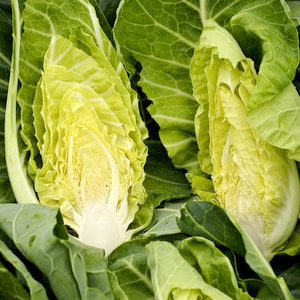What to do in your allotment in May
Written by Lee Senior
It’s May, and with three bank holidays this month there’s plenty of opportunity to head over to the allotment. The soil has been much wetter than perhaps we’d like this spring, and there’s certainly been nothing to gain by sowing and planting too early in these cold and wet conditions. Nevertheless, the weather hasn’t prevented my asparagus plants from producing wonderful succulent spears. Established plants can be cropped until mid-June when they should be left to grow undisturbed for the summer.
All the rain has meant that weeds and grass are growing rapidly. I’m always fascinated to see what other allotment holders use for their paths. Grass paths look nice when cut short, but unfortunately, the opposite is true when the grass gets too long. I’m a fan of decorative bark or gravel laid on top of a weed membrane to stop the weeds coming through. But that’s because I prefer to use my allotment time working the land!
One of the main jobs in May is to nurture and prepare young plants for life outdoors. Hardening off takes 2-3 weeks and should be completed by the end of this month. By then, the risk of frost is almost eliminated in most parts of the country. Hardening off is time consuming, but essential. And once the plants are out on your plot, cloches, fleece and portable ‘easy’ tunnels can all be used for extra protection if the weather is cold at night.
Happy growing!
Allotment flowers in May
- Plant out your sweet peas this month, after hardening them off.
- Lavender ‘Hidcote Blue’ seeds can be sown until early June. It makes a wonderful border plant in a well-drained, sunny position, and is equally happy in containers.
- An allotment wouldn’t be complete without nasturtiums. Try ‘Little Gem Mix’ for an easy-going striking display – it may even help in the fight against cabbage white caterpillars as they’re part of the brassica clan.
- There’s still time to sow annual flowers such as Afro-French Marigold ‘F1 Zenith Mix’. As well as looking great, they also deter whitefly so it’s a win-win for the allotmenteer.
- Calendula (sometimes known as pot marigold), with its lovely orange or yellow flowers, has been a stalwart on my plot for years. The plants are easily grown from seed and happily seed around. Attracting beneficial insects, they can also be used as a cut flower. Even better, the flower petals are edible!
- The tall varieties of sunflowers are a great way to attract children to the joys of allotment gardening. For something a little different why not try the bushy Sunflower ‘Total Eclipse’. Easy to grow, they reach a height of around 60cms and the blooms can be cut to fill vases.
- With an eye on next year, Sweet William seeds can be sown directly between now and July.
- Biennial wallflowers are showstoppers at this time of year. They’re easily grown from seed, so make a note to sow some later in the summer for flowers this time next year.
Allotment vegetables in May
- May is at the heart of the direct sowing calendar. The soil should be warm enough to sow beetroot, carrots, kohlrabi, parsnips, radishes, turnips and swedes. Try Kohlrabi ‘Purple and White Vienna Mix’ for pretty stems, and Beetroot ‘Rainbow Mix’ for a good selection of multi-coloured beets.
- If your soil is too heavy or stony for carrots to grow directly, try a large container but protect them from carrot fly. Only thin out your plants on still evenings and use a 4-sided micromesh barrier around your bed. Adult carrot flies can only fly up to around 3ft in height, so this is a good organic option. Alternatively, try nematodes to control the destructive carrot fly larvae. The F1 seed variety ‘Resistafly’ is resistant to carrot root fly attack and the F1 variety ‘Maestro’ is also a good option.
- It’s a busy time of year for brassica growers. Brussel sprouts, cabbage, cauliflower and kale should be planted out in their final positions this month once they’re hardened off. Make sure you net them to prevent cabbage white butterflies from laying their eggs on the leaves.
- Many other hardened-off vegetables such as courgette, leeks, pumpkin, runner beans, squash and sweet corn should all be planted out at the end of May or early June once the risk of frost has passed in your area.
- There’s still time to sow French beans and runner beans directly into their final positions. I must admit that I prefer to start them off in cells or trays to reduce losses.
- Early to mid-May is the final period when broad bean seeds can be sown until late autumn.
- Plant leek seedlings out in May, making sure they’re deep in the planting hole (up to half the height) to encourage a long, straight. blanched stem. Water well.
- Plant out hardy varieties of cucumber. Use cloches to protect the young plants from cool weather and water them well until they establish. In the greenhouse, there’s still time to sow cucumber seeds. ‘F1 Baby’ is fast growing and can be harvested from August-October.
- If the risk of a late frost has completely passed where you are, now’s a good time to plant outdoor tomato plants. Provide canes if they need support and keep them moist.
- Make sure your pea plants still have plenty of support. You don’t want them to blow over in windy conditions.
- May is a busy month in the potato calendar. Continue to plant your seed potatoes and protect any shoots above ground from frost. I tend to earth up the young shoots with soil or a temporary fleece covering to protect those vulnerable young shoots during cold snaps. If the worst happens and the plants get ‘frosted’, they should recover if they’re otherwise healthy, albeit with a loss of valuable growing time.
- There’s still time to plant all maincrop seed potato varieties before the middle of the month.
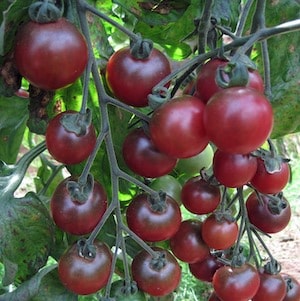
Image: Tomato Grafted Rosella (3)
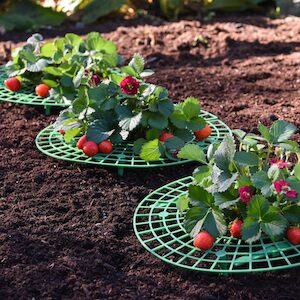
Image: strawberry supports
Allotment fruit in May
- It’s an exciting time of year as we discover just how successful fruit tree pollination has been as the flowers begin to set. Check the rootstocks of your fruit trees this month as they put on fresh growth. If you see any growth from the base (roots) of your grafted fruit trees, cut it away at the base with a clean, sharp pair of secateurs, cutting at an angle.
- Look out for codling moths on your fruit trees. Hang out moth traps towards the end of May to catch the male moths and prevent caterpillar damage to leaves.
- Keep blueberries well watered with lime-free water if the ground is dry or they’re grown in containers.
- Cover your strawberry plants with a bird protection net once the fruits start to form and lift the fruits off wet soil.
- It’s a similar story with other fruits such as blackcurrant, gooseberry, red currants and white currants in a few weeks time. These are also liable to be taken by hungry birds once ripe. I’ve seen pigeons strip redcurrant bushes almost literally overnight!
Crops to harvest in May
- May is a relatively quiet month for harvesting compared to much of the allotment calendar. Winter/early spring stalwarts such as broccoli, kale, parsnips and leeks have all come to an end. Leeks and parsnips make fine flowers for insects if you let them continue their lifecycle.
- Asparagus is in its main cropping season this month.
- Rhubarb is also plentiful and at its peak for harvesting.
- Spring (overwintered) cabbage is in season now, after sowing last July/August.
- Early spring sown radishes are now ready to harvest along with overwintered lettuce and spring onions for a tasty mini home-grown salad.
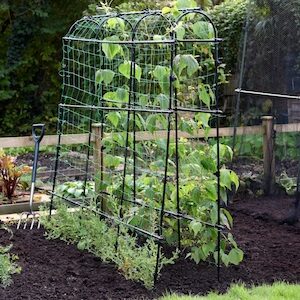
Image: Pea and bean tunnel
General May allotment jobs
- For the first half of May, focus on hardening off all seedlings before planting out. Move the pots or trays outdoors during the day for a week or two but bring them in every night.
- Don’t worry if you’re behind, or don’t have enough space for indoor seed sowing! Vegetable plug plants are a very convenient alternative.
- Stay vigilant for late frost – especially if you’re growing first and second early potatoes.
- Put out slug control in wet weather to protect young plants.
- If you don’t have time to weed properly, remove the flower heads from weeds like dandelions to stop them from going to seed and spreading.
- When you’re clearing bindweed from your allotment beds, make sure you remove as much of the plant material as possible. This weed will sprout new plantlets from even 1cm of root or stem left in the soil.
- Construct supports ready for planting out your climbing beans.
Planning ahead
- Plan for the higher temperatures in June by checking your water supply. Make sure you have water butts and consider setting up irrigation systems.
- Remember to take plenty of photos of your allotment over the next few months while growth is shooting ahead. This helps with planning later in the year.
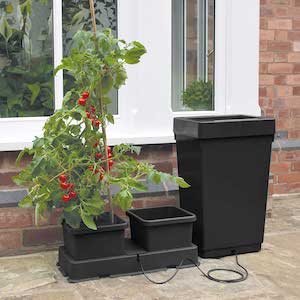
Image: Easy 2 Grow Irrigation Kit
Suttons Seeds recommend these areas which may also be of interest.
- Previous month: What to do in your allotment in April
- Next month: What to do in your allotment in June



